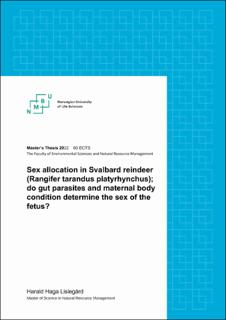| dc.description.abstract | Sex ratio is one of the most central demographic factors influencing species population dynamics. Intuitively, fetal sex ratio is a chance event resulting in 50 % males and 50 % females entering the population. However, in many wild birds and mammals this is not the case and sex ratios are skewed as a function of environmental and individual condition. Parasites have an ever-present influence on hosts populations and ecosystems reducing appetite, body condition and fecundity and even regulating host densities. New research has found that parasite-host interactions between a gastrointestinal nematode and a polygamous ungulate indirectly caused sex allocation through a negative effect on hosts body condition. Considering this, the present study examines fetus sex data from 80 individual Svalbard reindeer culled from 1995-2007 to explore if parasite-host interactions, body condition or age causes sex allocation in a novel polygamous ungulate. These relationships were analyzed using a principal component analysis, general linear models and partial least square path-modelling. This study found that fetal sex ratios of Svalbard reindeer followed the expected 1:1 sex ratio predicted from Fisher`s principle. Mothers showed no sign of favoring one sex over the other in relation with their individual age or fitness using back fat depth as a measurement of body condition. Neither of the two dominating abomasum larvae species(M.marshalli and O.gruehneri) had any direct nor indirect effect (through body condition) on the fetus sex. Furthermore, neither parasite species had a significant assossiation with body condition in Svalbard reindeer. Nevertheless, older animals decreased in body condition and increased in parasite abundance of O.gruehneri. The lack of fetal sex allocation in Svalbard reindeer may be caused by the harsh and unpredictable Arctic winter during pregnancy, with lower correlation between body condition in autumn and spring than in many other species. However, body condition and parasite burdens true effects on fetus sex ratios is uncertain in this study due to an offset of four to seven months between time of conception and sampling date. This study underlines the effect variating environmental stochasticity of winters can have on species living in Arctic ecosystems. In addition, it highlights the importance of timing the sampling period of sex allocation studies appropriately, if possible, around the specific specie`s time of conception. | en_US |

